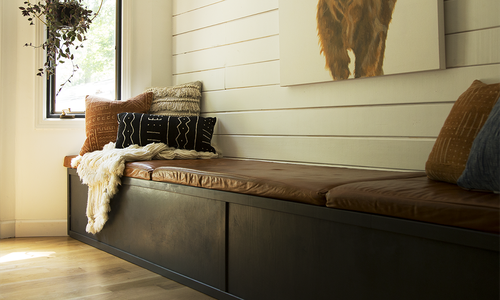DIY
The Best Indoor Plants for Your Home
Learn what plants thrive inside and where to place them, how to incorporate them into existing decor, best care practices and more with the help of Flora & Fern and Wickman’s Garden Village.
By Karen Bliss and Rebekah Olson
Sep 2017

You’ve worked all spring and summer cultivating your outdoor plants, but winter is coming. Now what? If you pick the right type of plants, you might be able to take them inside for the winter and style them to jazz up the look of your home. Caitlyn Franklin, a manager at Flora and Fern (Editor's Note: Since the initial publication of this article, Flora and Fern has closed.), says there are plenty of ways to decorate inside with potted plants this fall and winter.
Pick the Right Plant
Franklin says the determining factor of whether a plant can thrive in and decorate your house in the winter is within the plant’s variety. “A popular plant, which we sell at Flora and Fern, is the calathea plant,” she says. “It’s a jungle plant that grows in 50-degree temperatures or above, but they don’t need a lot of sun. It’s more of a shade plant.” Franklin says you can also grow poinsettias, elephant ear and staghorn ferns outside during summer and spring and bring them inside, potted, in the fall. When the weather gets warmer again, you can replant them outside.
Find the Right Pot, Basket or Planter
Not only is it important to find a functional pot, basket or planter for your plant, but it can also liven up your interior design. Your planter could be as simple as a plastic pot, which can be set down inside, or even a concrete box with legs. Hanging baskets are another creative option. “There are many styles of indoor hanging baskets,” Franklin says. “You could choose multiple plants and do a display of hanging plants in front of windows, or in a corner with indirect light [use] different plants to create a focal point of greenery.”
Coordinate with Your Interior Style
There are many ways to coordinate with the style you already have in your home, Franklin says. “Use plants as accents of color,” she says. “They come in all shades of greens, purples, etc. So consider your home decor and what would work with your existing colors.” Don’t be afraid to mix and match colors, styles and sizes of plants and pots. “We like things that look unusual and create a conversation piece,” Franklin says.
Care for Plants Properly
“How much care do you want to do inside with your plants?” Franklin asks. “How much water does your plant need? These are things you have to think about.” If you find the right lighting for the right plant in your home, then you need to check on what kind of plant food is needed and how often you need to water. If it’s really hard for you to remember when to water your plants, timers are always an option, Franklin says. “You can never have too many plants,” she says. “As long as you are willing to put in a little work to care for them, they can make a great room look even better and more alive.”
House Plants
Fiddle-Leaf Fig
With its big, violin-shaped leaves and waxy, dark-green foliage, the fiddle-leaf fig is certainly fashion-forward.
How Do I Incorporate It Into My Decor?
This plant will grow tall—6 feet or more—but it won’t be bushy, which means it’s perfect for tight corners and high ceilings.
Where Should I Put It?
Place it near a closed window, away from doors and air vents. This ficus is finicky about cold drafts.
How Do I Care for It?
Give it bright, consistent light, and water only when the soil is dry to the touch. Turn the plant every few months and plan to repot it once a year.
Will I Kill It?
Possibly. This plant thrives in warm, wet conditions—which aren’t always easy to provide inside of your home.
Pothos
This vining plant—adorned with pretty, almond-shaped leaves—looks great in a hanging basket, climbing a plant pole or spilling over the edge of a table.
How Do I Incorporate It Into My Decor?
Pothos vines grow to be 6 feet or longer, even when planted in confined pots. So hang yours high with vertical space to droop into.
Where Should I Put It?
In a macrame plant hanger. Pothos grows even in low-light conditions, so you can hang this plant just about anywhere!
How Do I Care for It?
Keep it at normal room temperature and keep the soil slightly on the dry side.
Will I Kill It?
Doubt it—this indoor plant is considered low maintenance, and great for beginners.
Air Plant
There are more than 600 air plant varieties, so you can own a full collection of these succulents. Plus, when they’re happy, they produce fragrant flowers.
How Do I Incorporate It Into My Decor?
Air plants don’t require soil, and most fit in your palm. Hang yours from the ceiling in glass terrariums, or set them on almost any surface for texture.
Where Should I Put It?
Keep them where they receive ample airflow and bright but indirect sunlight. They do best near a bathroom or kitchen window, where they can get a little steam and moisture.
How Do I Care for It?
An air plant absorbs nutrients through its leaves. Mist your plant with some water every day or two, and give it a bath in your kitchen sink once a week.
Will I Kill It?
Nope. Air plants are quite easy to care for.
Monstera Deliciosa
This flowering plant is iconic with split leaves that are practically art. Part evergreen, part statement piece, you can expect huge growth over the years, with long, winding roots outside of the pot.
How Do I Incorporate It Into My Decor?
Give it a bit of room. We suggest using it to replace the end table beside your couch, where it can spread out.
Where Should I Put It?
The Monstera is tolerant of low light and dry air but, again, it takes up a lot of space. Once mature, place it on the floor in the middle of a room.
How Do I Care for It?
Use demineralized water or rainwater instead of tap, and keep steady room temperatures of 70 to 75 degrees.
Will I Kill It?
You can try. In optimal conditions, this philodendron is a vigorous, tolerant grower.
Snake Plant
The leaves of this striking plant are marbled, sword-shaped and upright. It converts carbon dioxide into oxygen both day and night, and has a reputation for removing toxins from indoor air.
How Do I Incorporate It Into My Decor?
The plant’s clutter-free lines make it a popular choice for interiors. Keep it separate from others—standing bold and alone—for a modern look.
Where Should I Put It?
Because it tolerates low and artificial light, you can place it just about anywhere. We suggest putting small snake plants in built-in shelves and larger ones on your bedside table.
How Do I Care for It?
Water moderately from spring to fall and significantly less in the winter.
Will I Kill It?
No way! Its increasing popularity is because of its nearly indestructible qualities—perfect for first-time houseplant owners.











